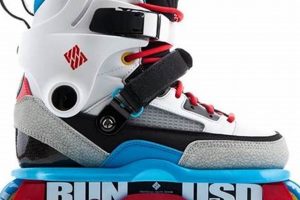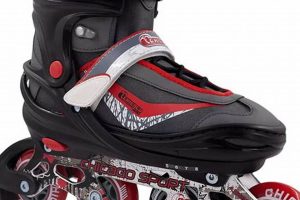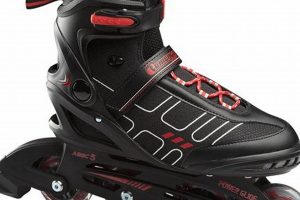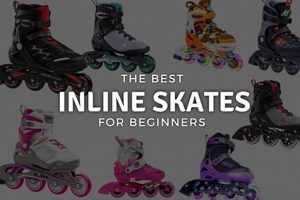Warning: Undefined array key "https://cruzskateshop.com/safety-inline-skates-for-seniors" in /www/wwwroot/cruzskateshop.com/wp-content/plugins/wpa-seo-auto-linker/wpa-seo-auto-linker.php on line 192
Specifically designed rolling footwear offers older adults a means of engaging in low-impact exercise and recreational activity. These devices prioritize stability and control, often incorporating features such as adjustable braking systems, supportive boot designs, and smaller wheel diameters to mitigate the risk of falls and enhance user confidence.
Maintaining physical activity is crucial for healthy aging. Participation in activities using these devices can contribute to improved cardiovascular health, enhanced balance and coordination, and increased muscle strength. Historically, inline skating has been associated with younger demographics, but adapted equipment and targeted training programs have broadened its accessibility to a wider age range.
The following sections will delve into the essential elements of selecting appropriate equipment, highlight effective techniques for maintaining balance and control, and discuss the crucial role of safety gear in mitigating the risks associated with recreational rolling for the mature adult.
Essential Guidelines for Mature Inline Skaters
This section provides actionable advice to maximize safety and enjoyment while engaging in inline skating. These guidelines are geared toward mature adults and emphasize risk mitigation.
Tip 1: Prioritize Protective Gear. Helmets are non-negotiable. Wrist guards, elbow pads, and knee pads are essential for mitigating the severity of potential falls. Ensure a snug, comfortable fit for all protective equipment.
Tip 2: Select the Appropriate Skating Environment. Smooth, paved surfaces, free from obstacles and vehicular traffic, are crucial. Avoid uneven terrain, steep inclines, and areas with high pedestrian density.
Tip 3: Maintain a Low Center of Gravity. Bend the knees slightly and lean forward from the ankles. This posture enhances stability and allows for more controlled movements.
Tip 4: Practice Fall Techniques. Learning to fall correctly can minimize injury. Aim to fall forward or to the side, distributing impact over a larger surface area. Practice falling in a controlled environment with protective gear.
Tip 5: Start Slowly and Gradually Increase Intensity. Begin with short, controlled skating sessions and gradually increase distance and speed as confidence and skill improve. Avoid overexertion.
Tip 6: Regularly Inspect Equipment. Before each use, inspect the skates for loose bolts, worn wheels, and properly functioning brakes. Maintain equipment in good working order.
Tip 7: Consider Professional Instruction. Qualified instructors can provide valuable guidance on proper technique, balance, and safety protocols. Investing in lessons can significantly reduce the risk of injury.
Adhering to these guidelines will contribute to a safer and more enjoyable experience. Prioritizing safety allows mature adults to reap the physical and mental benefits of inline skating.
The subsequent section will address the importance of regular maintenance and storage best practices for extending the lifespan and ensuring the continued safety of your equipment.
1. Braking Mechanisms
Braking mechanisms constitute a critical safety feature for rolling footwear utilized by senior adults. The functionality and responsiveness of these mechanisms directly influence the user’s ability to control speed and prevent collisions. Age-related decline in reaction time and physical dexterity necessitates braking systems that are intuitive, easily accessible, and highly effective. Traditional heel brakes may pose challenges for some seniors due to the required range of motion and balance. Alternative systems, such as cuff brakes or T-stop techniques, may offer more accessible and stable methods of deceleration.
The effectiveness of a braking system is directly correlated with the potential for injury reduction. For example, a readily accessible and properly maintained brake can prevent falls resulting from unexpected obstacles or changes in terrain. Conversely, a malfunctioning or poorly designed braking system increases the risk of accidents, potentially leading to fractures, sprains, or head injuries. Regular inspection and maintenance of braking components are therefore essential for ensuring continued safety. Instruction on proper braking techniques is also critical, as improper usage can negate the benefits of even the most advanced systems.
In summary, braking mechanisms play a fundamental role in mitigating risks associated with rolling footwear use among senior adults. Choosing appropriately designed and well-maintained systems, coupled with comprehensive training, is paramount to fostering safe and enjoyable participation in the activity. The selection process should prioritize ease of use, responsiveness, and overall effectiveness in accommodating the specific needs and physical capabilities of the user.
2. Ankle Support
Ankle support is a crucial component in the design of rolling footwear intended for senior users, directly influencing stability and reducing the likelihood of injuries. Age-related declines in muscle strength, bone density, and balance make the ankle joint particularly vulnerable to sprains and fractures. Inadequate ankle support during rolling activities can exacerbate these vulnerabilities, leading to falls and subsequent injuries. The presence of robust ankle support counteracts these risks by providing external stabilization, limiting excessive joint movement, and promoting a more controlled skating experience.
The effectiveness of ankle support is evident in several practical scenarios. For instance, consider a senior individual navigating uneven pavement while using rolling footwear. Without adequate ankle support, even minor surface irregularities can cause the ankle to roll inward or outward, potentially resulting in a sprain. However, a well-designed boot with sufficient ankle support can effectively resist this movement, maintaining the user’s balance and preventing injury. Similarly, during sudden stops or changes in direction, strong ankle support minimizes the risk of the ankle buckling under pressure. Examples of effective designs include high-cut boots with reinforced materials and adjustable closure systems that allow for a customized and secure fit.
In conclusion, ankle support plays a pivotal role in ensuring the safety of senior adults engaging in rolling activities. By mitigating the risks associated with age-related physical decline and providing external stabilization, robust ankle support promotes a more secure and controlled skating experience. The design and implementation of effective ankle support systems should be a primary consideration in the development of rolling footwear tailored to the specific needs and vulnerabilities of older users, helping them maintain mobility and independence while minimizing the risk of injury.
3. Wheel Durometer
Wheel durometer, a measure of a wheel’s hardness, significantly influences the safety and performance of inline skates, particularly for senior users. The selection of an appropriate durometer is paramount in mitigating risks and optimizing the skating experience for this demographic.
- Grip and Traction
Lower durometer wheels (e.g., 74A-82A) offer greater grip and traction on various surfaces. This is crucial for seniors, as enhanced grip reduces the likelihood of slippage and falls, especially on uneven or slightly rough terrains. Real-world examples include navigating sidewalks or paved paths with minor imperfections. The implication is increased stability and confidence while skating.
- Shock Absorption
Softer wheels, again characterized by lower durometer values, provide superior shock absorption compared to harder wheels. This is a key consideration for seniors, as it helps mitigate joint stress and discomfort caused by vibrations and impacts from the skating surface. The impact protection provided leads to decreased fatigue and a reduced risk of musculoskeletal strain during longer skating sessions.
- Speed and Roll
While harder wheels (e.g., 84A and above) offer greater speed and roll, they can compromise control and stability, particularly for less experienced skaters or those with balance challenges. Seniors often prioritize stability over speed, making softer wheels a safer and more suitable choice. Maintaining a controlled speed reduces the severity of potential falls and allows for quicker reaction times to hazards.
- Durability and Wear
Softer wheels tend to wear down more quickly than harder wheels, necessitating more frequent replacement. While this represents an added cost, the increased safety and comfort afforded by softer wheels often outweigh the inconvenience for senior users. Regular inspection of wheel condition is necessary to ensure optimal performance and continued safety.
Ultimately, the selection of wheel durometer for skating equipment designed for seniors involves a trade-off between grip, comfort, speed, and durability. Prioritizing grip and shock absorption through the use of softer wheels is often the most prudent choice for maximizing safety and promoting a positive skating experience. Continuous monitoring of wheel condition and adaptation of skating technique to surface conditions remain vital components of responsible skating practice.
4. Impact Protection
Impact protection is a critical design element in inline skates intended for senior users. Due to age-related physiological changes, such as decreased bone density and reduced muscle mass, older adults are at increased risk of injury from falls. Therefore, the integration of effective impact protection measures is paramount in mitigating the severity of potential injuries during skating activities.
Impact protection primarily functions through the absorption and distribution of kinetic energy generated during a fall. This can be achieved through various means, including the strategic placement of padding materials in key areas such as the ankles, heels, and sides of the skates. Materials like specialized foams and reinforced plastics are often employed to provide adequate cushioning and structural support. For instance, a skate featuring high-density foam padding around the ankle and a reinforced heel cup can significantly reduce the force transmitted to the ankle joint during a fall, thereby minimizing the risk of sprains or fractures. The effectiveness of impact protection is directly linked to the material properties and the design of the protective elements. Products meeting established safety standards offer a verifiable level of protection.
In conclusion, impact protection constitutes a non-negotiable aspect of safe inline skating equipment for senior individuals. The design of such equipment must prioritize the inclusion of effective padding and reinforcement to mitigate the risks associated with falls. The selection of inline skates for seniors should be guided by a thorough evaluation of the impact protection features, ensuring that the equipment provides an adequate level of protection to minimize the potential for serious injury. Failure to prioritize impact protection can have severe consequences for the health and well-being of older adult skaters.
5. Proper Fit
Proper fit is a foundational element of safe inline skating, particularly for senior adults. Ill-fitting skates directly compromise stability and control, increasing the likelihood of falls and subsequent injuries. Skates that are too large allow the foot to move excessively within the boot, reducing responsiveness and hindering precise movements. Conversely, skates that are too small can cause discomfort, restrict circulation, and lead to numbness, further impairing balance and control. A properly fitted skate should conform snugly to the foot, providing adequate support without creating pressure points. The connection is direct: inadequate fit causes instability, which in turn causes increased risk of accidents.
Consider the scenario of an older adult skating on a slightly uneven surface. If the skates are too large, the foot may shift laterally within the boot, causing the ankle to roll inward or outward. This loss of stability can easily lead to a fall, resulting in injuries ranging from sprains to fractures. On the other hand, if the skates are too tight, the resulting discomfort and restricted blood flow can impair sensation and coordination, increasing the risk of stumbling or losing balance. Moreover, improper fit can lead to blisters and chafing, distracting the skater and further compromising safety. Proper fit ensures efficient energy transfer from the skater to the skates, allowing for smoother and more controlled movements. An evaluation of fit should include considerations of length, width, and volume of the foot, accounting for individual variations and potential anatomical changes associated with aging.
In summary, the importance of proper fit in mitigating the risks associated with inline skating for seniors cannot be overstated. Ensuring a snug, comfortable, and supportive fit is paramount for maintaining stability, enhancing control, and preventing falls. Attention to the nuances of skate sizing and fitting, coupled with regular monitoring of foot comfort, is essential for promoting a safe and enjoyable skating experience. Ignoring the crucial role of proper fit can have significant consequences, underscoring the need for careful assessment and selection of appropriate equipment.
Frequently Asked Questions
This section addresses common inquiries regarding the safe use of rolling footwear by senior adults. The information provided aims to clarify misconceptions and offer guidance on best practices.
Question 1: Are rolling skates inherently dangerous for older adults?
Rolling skates, when used without appropriate safety precautions, can present risks to individuals of all ages. However, with proper equipment, training, and adherence to safety guidelines, the risks can be significantly mitigated for older adults. The decision to engage in skating activities should be made in consultation with a healthcare professional.
Question 2: What specific features should be prioritized when selecting rolling skates for senior use?
Key features to prioritize include effective braking mechanisms, robust ankle support, softer wheel durometer ratings, and adequate impact protection. A proper fit is also essential for maximizing stability and control. Furthermore, adjustable features allow for customization to individual needs.
Question 3: How can balance issues be addressed to improve safety while skating?
Balance issues can be addressed through targeted training exercises designed to improve core strength and stability. Starting slowly, practicing in controlled environments, and maintaining a low center of gravity are also effective strategies. The use of walking poles can provide additional support.
Question 4: What is the role of protective gear in mitigating the risk of injury?
Protective gear, including helmets, wrist guards, elbow pads, and knee pads, plays a crucial role in minimizing the severity of injuries resulting from falls. Consistent use of appropriately sized and well-maintained protective gear is strongly recommended.
Question 5: How frequently should rolling skates be inspected and maintained?
Rolling skates should be inspected before each use to ensure that all components are in good working order. Regular maintenance, including cleaning, lubrication, and replacement of worn parts, is essential for maintaining safety and performance. A professional assessment is advisable annually.
Question 6: Are there any medical conditions that would contraindicate the use of rolling skates?
Certain medical conditions, such as severe arthritis, osteoporosis, or balance disorders, may contraindicate the use of rolling skates. Consultation with a physician is recommended to assess individual risk factors and determine suitability for this activity.
Proper preparation, appropriate equipment selection, and adherence to safety guidelines are paramount for ensuring a safe and enjoyable skating experience for older adults. Continuous assessment of individual capabilities and environmental conditions is also essential.
The subsequent section will explore resources and organizations that provide support and guidance for senior skaters.
Safety Inline Skates for Seniors
This exploration has detailed critical aspects of safety inline skates for seniors, emphasizing braking mechanisms, ankle support, wheel durometer, impact protection, and proper fit. Prioritizing these features demonstrably reduces the risk of injury and enhances the potential for safe and beneficial participation in this recreational activity.
Informed decision-making, coupled with adherence to safety protocols, empowers senior adults to engage in inline skating with minimized risk. Continued research and development in skate technology, tailored to the specific needs of aging populations, hold the promise of further enhancing safety and accessibility. Promoting responsible skating practices remains paramount.




![Best Chicago Skates Inline Skates: [Year] Guide & More! Safem Fabrication - Precision Engineering & Custom Manufacturing Solutions Best Chicago Skates Inline Skates: [Year] Guide & More! | Safem Fabrication - Precision Engineering & Custom Manufacturing Solutions](https://cruzskateshop.com/wp-content/uploads/2025/06/th-3478-300x200.jpg)


